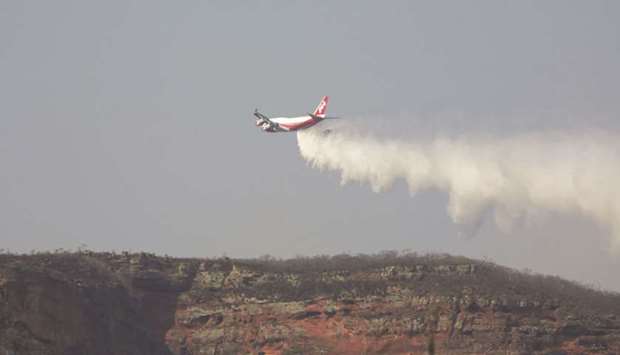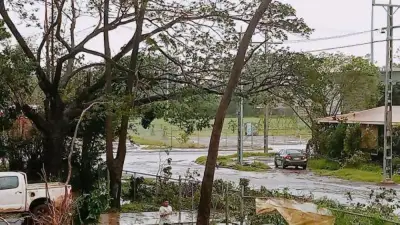Air transport accounts for roughly 2.5% of global man-made carbon dioxide emissions and is often the target of environmentalists around the world for being “massive polluters”.
The aviation industry, however, says it is shrinking its carbon footprint and its sustainability plan is among the “most ambitious and globally focused” of any industry.
As debate continues on the industry’s role in the global carbon footprint and initiatives aimed at reducing harmful emissions and overall pollution, a mammoth task to safeguard the environment and involving some airlines, is being undertaken in South America, where wildfires are raging through the Amazon, the largest rainforest in the world.
The Amazon spans eight countries, including Bolivia, though the majority of the forest is in Brazil. Often called “the planet’s lungs,” the Amazon forest produces about 20% of the world’s oxygen.
The Amazon rainforest has been on fire for the past month, with Brazil declaring a state of emergency in the region.
The number of fires in Brazil this year is the highest on record since 2013 and is up by 85% from last year alone, international broadcaster CNN reported. So far this year, more than 80,000 fires in the country have been detected by Brazil’s space research centre — INPE.
There are so many fires burning right now, that the smoke is visible even from space. A European Space Agency astronaut captured images of the smoke from the International Space Station a few days ago.
The astronaut said the haze is so widespread; it resembles clouds in some of the photos.
A Boeing ‘SuperTanker’ and many other aeroplanes and helicopters have been deployed to extinguish the raging wildfires in the region, one of the largest such aerial operations undertaken anywhere in the world so far.
Recently, Bolivia took delivery of the SuperTanker, said to be the world’s largest firefighting plane to help fight wildfires that have devastated vast swathes of forest and agricultural land.
The government hired the Boeing 747-400 plane after failing to extinguish fires that have already destroyed around 7,770 square kilometres (3,000 square miles) of the eastern province of Santa Cruz in just a month alone.
The Boeing aircraft, leased from a US company, can carry 150,000 litres (40,000 gallons) of water or fire retardant.
The B747-400 SuperTanker is in the category of Very Large Airtankers (VLAT) used for fighting fires. It is capable of dropping around 19,000 gallons of retardant per trip, according to the company’s website.
Dan Reese, president of Global SuperTanker, travelled to South America as part of a 14-person team to battle the fires in Bolivia. He told CNN there are “an unbelievable number of fires” in the Amazon and his company is part of the response.
The company recently said it had completed three sorties and was preparing for a fourth. “The SuperTanker and our helicopters work to put out the fire,” he said.
“I appreciate the efforts of so many compatriots, men and women, who work on this hard task. We face this battle against fire together.”
Air Force planes also began reconnaissance flights to determine where the Boeing aircraft can most effectively drop its huge payload.
“Four aircraft left to survey six places” in the eastern province of Santa Cruz, said a senior Bolivian official.
Recently, the G7 countries after their summit in France offered Brazil $20mn, mainly to step up aerial firefighting. However, Brazil had rejected the offer.
But given the enormous task at hand, it remains to be seen whether the aerial firefighting will help totally contain the raging wildfires in Amazon, which geographically, is even bigger than Europe and restore the world’s largest rainforest, which is dubbed the “planet’s lungs”.
Firefighters say that only heavy rains, which are forecast to lash the affected Amazon region, can effectively douse the rapidly spreading fire.
The Amazon is a vital carbon store that slows down the pace of global warming. It is known as the “lungs of the world” and is home to about three million species of plants and animals, and one million indigenous people.
In respect of the aviation’s “environment commitments”, its leaders are saying they are making huge efforts to reduce the industry’s 2.5% share of global carbon emissions.
In 2009 it has set tough CO2 targets, including carbon-neutral growth from 2020 and to cut emissions to half of 2005 levels by 2050. Achieving these aims will bring aviation in line with the Paris climate target.
* Pratap John is Business Editor at Gulf Times.

A SuperTanker aircraft releases water over Ipias, an area where wildfires have destroyed hectares of forest, near Robore, Bolivia. The B747-400 SuperTanker is in the category of Very Large Airtankers (VLAT), capable of dropping around 19,000 gallons of retardant per trip, according to the company’s website. Recently, Bolivia took delivery of the SuperTanker, said to be the world’s largest firefighting plane.



